In commutative algebra, the prime spectrum of a ring R is the set of all prime ideals of R, and is usually denoted by ; in algebraic geometry it is simultaneously a topological space equipped with the sheaf of rings .

In algebraic geometry, a projective variety over an algebraically closed field k is a subset of some projective n-space over k that is the zero-locus of some finite family of homogeneous polynomials of n + 1 variables with coefficients in k, that generate a prime ideal, the defining ideal of the variety. Equivalently, an algebraic variety is projective if it can be embedded as a Zariski closed subvariety of .
In algebraic geometry, a branch of mathematics, Serre duality is a duality for the coherent sheaf cohomology of algebraic varieties, proved by Jean-Pierre Serre. The basic version applies to vector bundles on a smooth projective variety, but Alexander Grothendieck found wide generalizations, for example to singular varieties. On an n-dimensional variety, the theorem says that a cohomology group is the dual space of another one, . Serre duality is the analog for coherent sheaf cohomology of Poincaré duality in topology, with the canonical line bundle replacing the orientation sheaf.
In mathematics, especially in algebraic geometry and the theory of complex manifolds, coherent sheaves are a class of sheaves closely linked to the geometric properties of the underlying space. The definition of coherent sheaves is made with reference to a sheaf of rings that codifies this geometric information.
In mathematics, Kähler differentials provide an adaptation of differential forms to arbitrary commutative rings or schemes. The notion was introduced by Erich Kähler in the 1930s. It was adopted as standard in commutative algebra and algebraic geometry somewhat later, once the need was felt to adapt methods from calculus and geometry over the complex numbers to contexts where such methods are not available.
In mathematics, algebraic geometry and analytic geometry are two closely related subjects. While algebraic geometry studies algebraic varieties, analytic geometry deals with complex manifolds and the more general analytic spaces defined locally by the vanishing of analytic functions of several complex variables. The deep relation between these subjects has numerous applications in which algebraic techniques are applied to analytic spaces and analytic techniques to algebraic varieties.

In algebraic geometry, a linear system of divisors is an algebraic generalization of the geometric notion of a family of curves; the dimension of the linear system corresponds to the number of parameters of the family.
In mathematics, a distinctive feature of algebraic geometry is that some line bundles on a projective variety can be considered "positive", while others are "negative". The most important notion of positivity is that of an ample line bundle, although there are several related classes of line bundles. Roughly speaking, positivity properties of a line bundle are related to having many global sections. Understanding the ample line bundles on a given variety X amounts to understanding the different ways of mapping X into projective space. In view of the correspondence between line bundles and divisors, there is an equivalent notion of an ample divisor.
In algebraic geometry, a closed immersion of schemes is a morphism of schemes that identifies Z as a closed subset of X such that locally, regular functions on Z can be extended to X. The latter condition can be formalized by saying that is surjective.
In mathematics, coherent duality is any of a number of generalisations of Serre duality, applying to coherent sheaves, in algebraic geometry and complex manifold theory, as well as some aspects of commutative algebra that are part of the 'local' theory.
In algebraic geometry, Proj is a construction analogous to the spectrum-of-a-ring construction of affine schemes, which produces objects with the typical properties of projective spaces and projective varieties. The construction, while not functorial, is a fundamental tool in scheme theory.
In mathematics, especially in algebraic geometry and the theory of complex manifolds, the adjunction formula relates the canonical bundle of a variety and a hypersurface inside that variety. It is often used to deduce facts about varieties embedded in well-behaved spaces such as projective space or to prove theorems by induction.
In mathematics, especially in algebraic geometry and the theory of complex manifolds, coherent sheaf cohomology is a technique for producing functions with specified properties. Many geometric questions can be formulated as questions about the existence of sections of line bundles or of more general coherent sheaves; such sections can be viewed as generalized functions. Cohomology provides computable tools for producing sections, or explaining why they do not exist. It also provides invariants to distinguish one algebraic variety from another.
In mathematics, a projective bundle is a fiber bundle whose fibers are projective spaces.
This is a glossary of algebraic geometry.
In algebraic geometry, the theorem on formal functions states the following:
In mathematics, a sheaf of O-modules or simply an O-module over a ringed space (X, O) is a sheaf F such that, for any open subset U of X, F(U) is an O(U)-module and the restriction maps F(U) → F(V) are compatible with the restriction maps O(U) → O(V): the restriction of fs is the restriction of f times that of s for any f in O(U) and s in F(U).
In algebraic geometry, given a morphism f: X → S of schemes, the cotangent sheaf on X is the sheaf of -modules that represents S-derivations in the sense: for any -modules F, there is an isomorphism
In algebraic geometry, the dualizing sheaf on a proper scheme X of dimension n over a field k is a coherent sheaf together with a linear functional
In mathematics, the base change theorems relate the direct image and the inverse image of sheaves. More precisely, they are about the base change map, given by the following natural transformation of sheaves:







